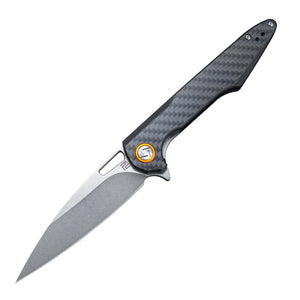Mastering the Art of Knife Flipping: A Beginner's Guide
Cuerpo
Knife flipping, also known as blade flipping or knife spinning, is a captivating skill that combines dexterity, precision, and creativity. Whether you are a beginner or an experienced enthusiast, this guide will provide you with valuable insights and techniques to enhance your knife flipping abilities.

The Basics of Knife Flipping
Before diving into the intricacies of knife flipping, it is essential to understand the fundamental aspects of this art form. Knife flipping involves manipulating a knife in mid-air, executing various flips, spins, and tricks. The objective is to achieve a seamless flow of movements while maintaining control over the knife.
One of the first steps in mastering knife flipping is to familiarize yourself with the different parts of a knife. Understanding the anatomy of a knife, including the blade, handle, and pivot point, will enable you to execute maneuvers with precision and confidence.
Developing Proper Technique
Developing proper technique is crucial for mastering the art of knife flipping. It is essential to start with the basics and gradually progress to more advanced maneuvers. Here are some key techniques to focus on:
1. Grip and Finger Placement
The grip plays a vital role in knife flipping. The most common grip used by beginners is the hammer grip, where the knife handle rests between the index and middle finger, with the thumb supporting the blade. As you advance, you can experiment with other grips, such as the pinch grip or the icepick grip, to achieve different flipping styles.
Proper finger placement is equally important. Placing your fingers too close to the blade can lead to accidents, while placing them too far from the pivot point may hinder your control over the knife. Finding the right balance is key to executing flips smoothly.
2. Flipping Techniques
There are various flipping techniques that you can explore as you progress in your knife flipping journey. Some popular techniques include:
- Aerial Flips: Aerial flips involve flipping the knife in the air without any contact with the hand. This technique requires precise timing and control.
- Chaplin Flips: Chaplin flips involve flipping the knife using the thumb and index finger, creating a spinning motion. This technique is often used for quick and flashy tricks.
- Behind the 8-Ball: Behind the 8-Ball is a more advanced technique that involves flipping the knife behind the back, passing it from one hand to the other. This maneuver requires coordination and practice.
Mastering the Art of Knife Flipping: A Beginner's Guide
Mastering the art of knife flipping requires dedication, practice, and patience. Here are some tips to help you on your journey:
1. Start with a Trainer Knife
When beginning your knife flipping journey, it is advisable to start with a trainer knife. A trainer knife is a specialized tool designed for practice, featuring a blunt or rounded blade to minimize the risk of injury. Using a trainer knife allows you to focus on mastering the techniques without the fear of accidents.
2. Practice in a Safe Environment
Knife flipping should always be practiced in a safe environment. Find a spacious area with a soft surface, away from any fragile objects or people. It is crucial to prioritize safety and minimize the risk of accidents.
3. Seek Guidance and Learn from Others
Joining a knife flipping community or seeking guidance from experienced flippers can greatly accelerate your progress. Online forums, tutorials, and workshops provide valuable insights, tips, and tricks from seasoned practitioners. Learning from others' experiences and sharing your own can foster growth and innovation within the knife flipping community.
4. Experiment and Create Your Style
While it is essential to learn from established techniques, don't be afraid to experiment and develop your unique style. Knife flipping is an art form that allows for personal expression and creativity. Embrace your individuality and explore new tricks and maneuvers to make your flips truly stand out.
Mastering the art of knife flipping is a journey that requires dedication, practice, and a passion for the craft. By following these tips and techniques, you can embark on an exciting adventure that will continually challenge and reward you.
Conclusion
Knife flipping is a captivating skill that combines precision, creativity, and dexterity. By mastering the art of knife flipping, you can unlock a world of endless possibilities and create mesmerizing displays of skill. Remember to always prioritize safety, seek guidance from experienced flippers, and embrace your own unique style. Now, it's time to grab your knife and start flipping!
References:
2. BladeFlippersAssociation.org










Comentarios